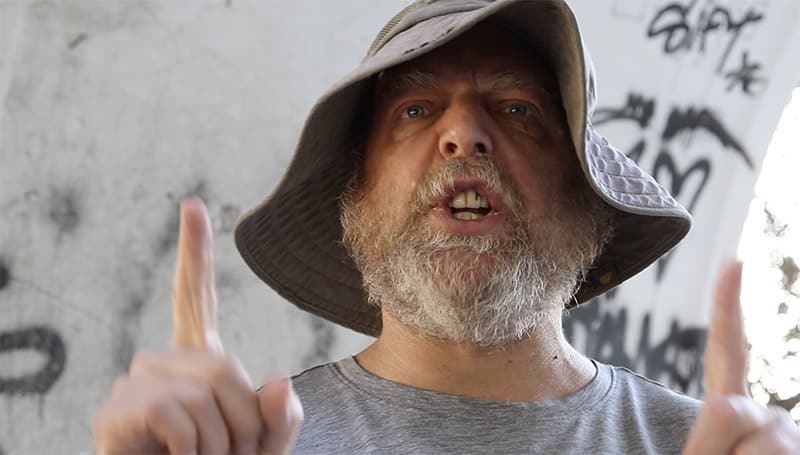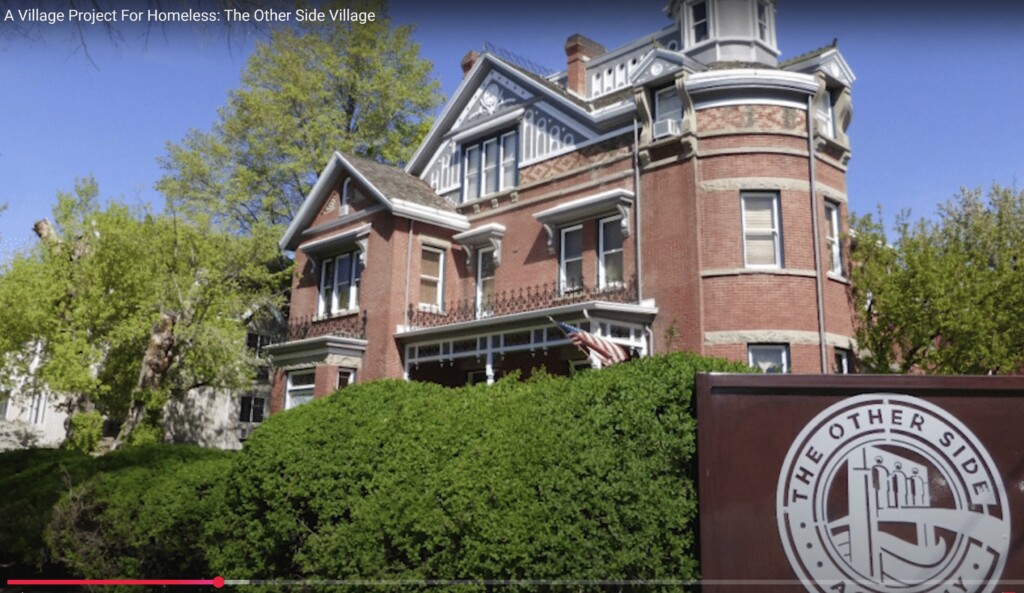
Every night there are anywhere from 1,000 up to 2,000 people in Utah sleeping on the streets, along riverways, squatting in parks, or wandering around trying to find safety and security, most are in Salt Lake County, but the number is growing as every city along the Wasatch Front is facing housing shortages.
Michael Sussman is one of these unsheltered people. With a cracked tooth and disheveled hair, bloated belly, Sussman’s exterior make him appear older than his age. But he is certainly suffering from something like paranoid schizophrenia and needs assistance.
Sussman was evicted from Grace Mary Manor for being behind in his rent (among other factors). Utah Stories attempted to get the official reason why Sussman was evicted from Grace Mary, which offers Housing First units or “permanent supportive housing”, in which tenants should never be evicted for financial reasons, but Grace Mary said they could not offer details on Sussman’s case or additional information because this information is “private”. Sussman’s rent for his studio-one-bedroom unit was just $300 per month, as Grace Mary Manor is subsidized by Salt Lake City Housing Connect.
Back at the beginning of July 2022, Sussman found himself once again on the streets trying to find a safe place to stay. He had been homeless for seven years off and on prior to getting into Grace Mary. Sussman kept all of his belongings in a downtown storage unit, costing him around $100 per month. While his things were safe, he was not. Sussman said he was skeptical about his chances of surviving another stint on the streets, “I rarely sleep for more than a few hours when I’m outside. I’ve been assaulted, attacked, and robbed while sleeping in parks… I just don’t know if I can make it this time” Sussman is a long way from retirement age, but he suffers from gout, and severe plantar fasciitis, which he says makes it impossible for him to do manual labor jobs or remain very long on his feet.
Sussman has degrees in French and German. He taught English in Africa. But he says after he got into an altercation with the police a few years ago, (he says they attacked him) he lost his ID and his life spiraled downhill, so he began living on the streets.
Sussman is articulate and passionate about his Jewish faith: he believes that nearly all homeless advocates are anti-semites. He believes Christians and homeless advocates are persecuting him because they have BBQs without kosher meats and they hold religious services to “false Gods” and require him to participate to receive services.
He has villainized his caseworkers, Grace Mary, The Road Home, and everyone who has tried to help him. Sussman appears a perfect candidate for Housing First, but he was kicked out. Why? We will return to Sussman’s story later.
The point is, that Sussman and his story are not unusual. Many semi-skilled professionals are finding themselves priced out of the housing market due to medical issues; the absence of family support and treatable mental disorders.
People Who Get Stuck
Hanging out with unsheltered, homeless individuals for the past ten months, I have yet to find someone who wants to be homeless. Some tell me they are “homeless by choice.” But by that they usually mean they escaped severe domestic abuse and determined it safer to be on the streets rather than remain in their former home/family life situation. Nobody I’ve met just wants to remain in parks and do drugs all day. Nobody plans on continuing this lifestyle long-term and nearly everyone is working towards bettering their situation.
Many of the homeless I’ve spoken to are in a holding pattern. They are stuck. This is because, as most of them say, they are, “waiting for housing.” Or “trying to get into housing.” Sussman has been waiting to get into housing for the past three months. Will Utah leaders act to get more people into housing quickly?
The Otherside Village: Salt Lake County’s Answer to Deeply Affordable Housing
The Otherside Village, a planned tiny home community wants to provide just such “deeply affordable housing” that is so desperately needed. Salt Lake City Mayor Erin Mendenhall mentioned how she was backing this idea in March 2021, but they still have yet to get final approval or break ground. With so many unsheltered Utahn’s just waiting, while many of them are desperately suffering– why is this taking so long?
Samuel Grenny, who is the Chief PR person for the Otherside Village, was a recent guest on the Utah Stories Show. He said that when they first began they had no real expectations of the timelines for projects that require so many approvals. Now he says that some people are surprised how fast they are moving along, given all of the hoops they have had to jump through.
Grenny’s father Joseph Grenny started the Otherside Academy, which has done an incredible job turning around the lives of felons and convicts stuck in the pattern of crime/punishment and drug abuse. Samuel Grenny has spent time in jail and he came to the same surprising conclusion interacting and becoming friends with his fellow inmates, he said. “Nobody wants to remain in jail or go in and out of jail. Everybody wants to find a better path, the problem is that people get stuck.
Grenny and the Otherside Village’s goal is to assist people in getting out of the morass of sleeping on the streets, using drugs, and committing crimes: patterns that Salt Lake City’s criminal justice resources are not proving as effective at solving as they were in years past. But these are the issues that Otherside village wants to make inroads with what they believe is a secret formula.
Drug Abuse Recovery And Prevention in Utah: Peer-to-Peer Counseling Model
Currently between 40-60% of people who attempt to get off drugs and alcohol relapse. David Droucher who is the Executive Director of the Otherside Academy says, this is because “90-day programs don’t work. That’s just the length of time until funding runs out.” They are recipes for failure…Nobody ‘recovers’ from severe behavioral disorders in 90-days.
Otherside Academy program offers closer to 85% effectiveness, for those who complete the entire two-year program. The sobriety rate is 95% for those who remain affiliated with the OtherSide program for three years.
The Otherside Academy’s unique model is called “peer-to-peer counseling”. “It’s much easier for a city to build affordable housing units than to provide the support services that the tenants in the housing need,” said Samuel Grenny. The Otherside Village also plans to use an adaptation to this concept by building a “Therapeutic community” offering peer-to-peer support. The same model that has made the Otherside Village such a resounding success, despite that facility having no paid therapists. We learned from Jean Hill of the Catholic Community Diocese that the major problem with the Housing First Model in Utah is that even for the formerly homeless who are in supportive housing units, there aren’t nearly enough counselors to be assisting both drug addicts and those suffering from mental disorders.
Michael Sussman–says he could possibly afford up to $500 per month for housing costs if such housing were available and he could take on some work. But he says he is not seeking employment because if he were to obtain a job he would lose all of his SSI benefits and food stamps, which he absolutely needs considering his medical problems. “I can’t earn more than about $100 per month if I want to keep my benefits.” Sussman believes he is stuck. When or how mentally ill unsheltered people like Sussman could be unstuck depends on how motivated Utah’s political leaders are in solving the housing crisis.
RELATED CONTENT
Homeless Population in Utah Increases Due to Seniors Being Priced out of the Rental Market
Salt Lake City’s Homeless Abatement Policies Examined
Investigating Homelessness Death and Public Safety in Utah
New York Times Journalist Appalled by the Homeless Situation in Salt Lake





